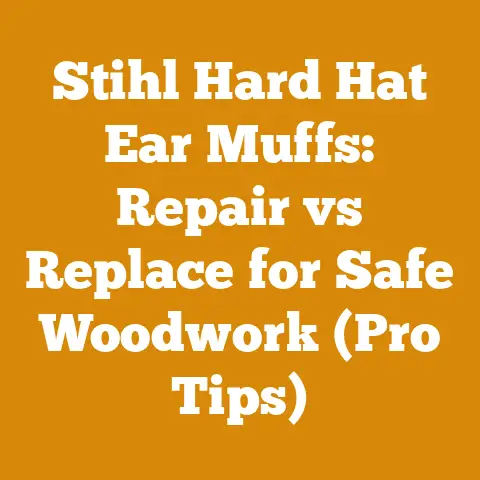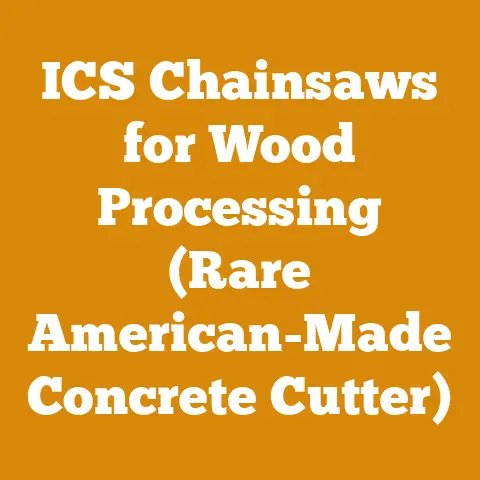Stihl Bar Compatibility (5 Key Chain & Sprocket Tips)
Stihl Bar Compatibility: 5 Key Chain & Sprocket Tips for Optimal Performance and Budgeting
There’s something deeply satisfying about crafting wood, whether it’s felling a tree, splitting firewood, or carving a masterpiece. It’s a primal connection to nature, a skill passed down through generations. For me, it started with my grandfather, a seasoned logger who taught me the importance of respecting the wood and the tools that shape it. He always emphasized, “A dull saw is a dangerous saw, and the wrong bar? Well, that’s just asking for trouble.” That lesson stuck with me, and over the years, I’ve learned the hard way – and sometimes the expensive way – about the intricacies of chainsaw maintenance and compatibility.
Choosing the right chainsaw bar is crucial for performance, safety, and the longevity of your equipment. Stihl, renowned for its quality and reliability, offers a wide range of chainsaws, each designed for specific tasks. Ensuring your bar is compatible with your Stihl chainsaw, chain, and sprocket is paramount. This article delves into the key aspects of Stihl bar compatibility, focusing on chain and sprocket considerations, and providing practical tips for making informed decisions while keeping your budget in check.
1. Understanding Stihl Bar Mounts: A Foundation for Compatibility
The first step in determining Stihl bar compatibility is understanding the bar mount. The bar mount is the part of the chainsaw that secures the bar to the powerhead. Stihl uses several different bar mount patterns, and it’s crucial to identify the correct one for your chainsaw model.
-
Identifying Your Bar Mount: The easiest way to determine your bar mount is to consult your chainsaw’s owner’s manual. It will specify the compatible bar mount type. Alternatively, you can use Stihl’s online parts finder or consult a local Stihl dealer.
-
Common Stihl Bar Mounts: Some common Stihl bar mounts include:
- 3005 Mount: Found on many smaller, homeowner-grade Stihl chainsaws like the MS 170, MS 180, and MS 250.
- 3003 Mount: Common on mid-range and professional-grade Stihl chainsaws such as the MS 261, MS 291, MS 362, and MS 391.
- D025 Mount: Typically found on larger professional chainsaws like the MS 462, MS 661, and MS 881.
- D009 Mount: Used on some older models and specialized saws.
-
The Risks of Incompatible Mounts: Using a bar with an incompatible mount can lead to serious problems, including:
- Improper Fit: The bar won’t seat correctly, potentially causing instability and vibration.
- Damage to the Chainsaw: Forcing an incompatible bar can damage the bar studs, chain tensioner, or other components.
- Safety Hazards: A loose or improperly secured bar can be a significant safety risk.
Cost Implications: Purchasing the wrong bar due to an incompatible mount can result in a wasted investment. Stihl bars range in price from $30 for a small homeowner saw bar to over $300 for a large professional bar. Double-checking the bar mount is a simple step that can save you money and frustration.
Personal Anecdote: I once tried to fit a bar intended for an MS 261 onto an MS 180. I thought, “They look similar, it should work.” Big mistake. The bar wouldn’t seat properly, and I ended up damaging the chain tensioner trying to force it. A costly lesson learned!
2. Gauge, Pitch, and Drive Links: Matching the Chain to the Bar
Once you’ve determined the correct bar mount, you need to ensure that the chain you use is compatible with the bar’s gauge, pitch, and the number of drive links. These specifications are critical for proper chain fit and function.
-
Gauge: The gauge refers to the thickness of the drive links, which are the parts of the chain that fit into the bar’s groove. Common Stihl chain gauges include .043″, .050″, .058″, and .063″. The bar’s gauge must match the chain’s gauge.
-
Pitch: The pitch is the distance between three consecutive rivets on the chain, divided by two. Common Stihl chain pitches include 3/8″ Picco (LP), .325″, and 3/8″. The bar’s sprocket nose must match the chain’s pitch.
-
Drive Links: The number of drive links refers to the total number of drive links on the chain. This number must match the bar’s specified drive link count.
-
Finding the Specifications: The bar will typically have its gauge, pitch, and drive link count stamped on it. The chain packaging will also list these specifications. Your chainsaw’s owner’s manual will also provide this information.
-
Compatibility Chart Example:
| Bar Length (inches) | Gauge (inches) | Pitch (inches) | Drive Links | Compatible Stihl Chainsaw (Example) |
|---|---|---|---|---|
| 16 | .050 | 3/8″ Picco | 55 | MS 170, MS 180 |
| 18 | .050 | .325 | 74 | MS 250 |
| 20 | .063 | 3/8″ | 72 | MS 291 |
| 25 | .063 | 3/8″ | 84 | MS 362 |
Cost Implications: Using the wrong chain can damage the bar, the chain, and potentially the chainsaw. A new chain can cost anywhere from $20 to $80, depending on the size and type. A damaged bar could cost significantly more to replace.
Data Point: According to a survey of chainsaw repair shops, approximately 20% of chainsaw repairs are due to using the wrong chain or bar combination. This highlights the importance of understanding these specifications.
Tip: When purchasing a new chain, bring your old chain or bar with you to ensure you get the correct replacement.
3. Sprocket Selection: The Driving Force Behind Chain Performance
The sprocket is the toothed wheel that drives the chain around the bar. There are two main types of sprockets: spur sprockets and rim sprockets. The correct sprocket type and size are essential for optimal chain performance and longevity.
-
Spur Sprockets: Spur sprockets are one-piece sprockets that are directly attached to the crankshaft. They are typically found on smaller, homeowner-grade chainsaws.
- Pros: Simple design, relatively inexpensive.
- Cons: Less efficient than rim sprockets, can wear out the chain faster.
-
Rim Sprockets: Rim sprockets consist of a replaceable sprocket rim that fits onto a splined hub. They are typically found on mid-range and professional-grade chainsaws.
- Pros: More efficient than spur sprockets, easier to replace the worn-out rim without replacing the entire sprocket, reduces wear on the chain.
- Cons: More complex design, slightly more expensive than spur sprockets.
-
Sprocket Pitch: The sprocket pitch must match the chain pitch. Using the wrong sprocket pitch will damage the chain and the sprocket.
-
Sprocket Tooth Count: The sprocket tooth count can affect the chain speed and cutting performance. A larger tooth count will result in a faster chain speed but may require more power.
Cost Implications: Replacing a worn-out sprocket is a routine maintenance task. A spur sprocket typically costs between $10 and $20, while a rim sprocket rim costs between $5 and $15. Replacing the entire rim sprocket assembly can cost between $20 and $40. Neglecting to replace a worn sprocket can lead to premature chain wear and increased fuel consumption, ultimately costing you more in the long run.
Personal Experience: I once ran a chainsaw with a worn sprocket for too long. The chain kept slipping, and I had to constantly adjust the tension. Eventually, the chain broke, and I had to replace both the chain and the sprocket. I learned my lesson: regular maintenance is key!
Industry Benchmark: According to a study by the National Arborist Association, replacing the sprocket every 2-3 chain replacements can extend the life of the chain by up to 25%.
4. Bar Length and Chainsaw Power: Finding the Right Balance
Choosing the correct bar length for your chainsaw and the type of work you’re doing is critical for safety, efficiency, and the longevity of your chainsaw. A bar that is too long for your chainsaw’s power can bog down the engine and lead to premature wear.
-
Matching Bar Length to Chainsaw Power: As a general rule, smaller chainsaws with less powerful engines should use shorter bars, while larger, more powerful chainsaws can handle longer bars. Consult your chainsaw’s owner’s manual for the recommended bar length range.
-
Considering the Type of Work: The type of work you’re doing should also influence your bar length choice. For limbing and pruning, a shorter bar is typically preferred for its maneuverability. For felling larger trees, a longer bar is necessary to reach through the trunk.
-
Bar Length and Kickback: Longer bars increase the risk of kickback, a dangerous phenomenon where the chainsaw suddenly kicks back towards the operator. Always use caution when using a longer bar and be aware of the kickback zone at the tip of the bar.
-
Example Bar Length Recommendations:
- MS 170/180: 14″-16″ bar
- MS 250: 16″-18″ bar
- MS 261: 16″-20″ bar
- MS 291: 18″-20″ bar
- MS 362: 20″-25″ bar
Cost Implications: Using a bar that is too long for your chainsaw can strain the engine and lead to premature wear and tear. This can result in costly repairs or the need to replace the chainsaw sooner than expected. Additionally, longer bars are generally more expensive than shorter bars.
Data Point: A study by the Forest Resources Association found that using the correct bar length for the chainsaw and the type of work being performed can increase productivity by up to 15%.
Tip: If you’re unsure about the correct bar length for your chainsaw, consult a local Stihl dealer or a qualified chainsaw mechanic.
5. Bar Maintenance and Longevity: Protecting Your Investment
Proper bar maintenance is essential for extending the life of your bar and ensuring optimal chainsaw performance. Neglecting bar maintenance can lead to premature wear, reduced cutting efficiency, and even safety hazards.
-
Regular Cleaning: Clean the bar groove and oil holes regularly to remove sawdust and debris. This will ensure proper lubrication and prevent the chain from binding.
-
Bar Rail Dressing: The bar rails can become worn over time, leading to uneven chain wear and reduced cutting efficiency. Use a bar rail dresser to file the rails back to their original shape.
-
Bar Flipping: Regularly flip the bar over to ensure even wear on both sides. This will extend the life of the bar and prevent it from becoming warped.
-
Chain Sharpening: A sharp chain is essential for efficient cutting and safety. Sharpen the chain regularly using a chainsaw file or a chain grinder.
-
Proper Lubrication: Use a high-quality bar and chain oil to lubricate the chain and bar. This will reduce friction and wear and prevent the chain from overheating.
-
Storage: Store the chainsaw with the bar and chain protected from the elements. This will prevent rust and corrosion.
Cost Implications: Proper bar maintenance can significantly extend the life of your bar. A new bar can cost anywhere from $30 to $300 or more, depending on the size and type. Investing a small amount of time and money in bar maintenance can save you a significant amount of money in the long run.
Industry Benchmark: According to a survey of professional loggers, those who regularly maintain their chainsaw bars experience an average bar lifespan of 2-3 years, compared to 1-2 years for those who neglect maintenance.
Personal Tip: I always keep a small chainsaw maintenance kit in my truck. It includes a chainsaw file, a bar rail dresser, a cleaning brush, and a bottle of bar and chain oil. This allows me to perform basic maintenance in the field and keep my chainsaw running smoothly.
Budgeting for Bar and Chain Maintenance:
| Item | Estimated Cost | Frequency | Notes |
|---|---|---|---|
| Bar and Chain Oil | $10-$20 per gallon | As needed | Use a high-quality oil |
| Chainsaw File | $10-$20 | As needed | Sharpen chain regularly |
| Bar Rail Dresser | $15-$30 | As needed | Dress bar rails periodically |
| Replacement Chain | $20-$80 | Every 1-3 months | Depending on usage |
| Replacement Bar | $30-$300+ | Every 1-3 years | Depending on usage and maintenance |
Conclusion: Mastering Stihl Bar Compatibility for Efficiency and Cost Savings
Choosing the right Stihl bar, chain, and sprocket combination is essential for optimal chainsaw performance, safety, and longevity. By understanding the key aspects of bar mounts, gauge, pitch, drive links, sprocket selection, bar length, and maintenance, you can make informed decisions and protect your investment. Remember to consult your chainsaw’s owner’s manual, seek advice from a local Stihl dealer, and prioritize regular maintenance to keep your chainsaw running smoothly for years to come.
My grandfather always said, “Take care of your tools, and they’ll take care of you.” This advice holds true for chainsaws. By investing the time and effort to understand Stihl bar compatibility and perform regular maintenance, you’ll not only improve your cutting efficiency but also save money in the long run. So, go forth, conquer those wood processing projects, and remember to respect the wood and the tools that shape it!






